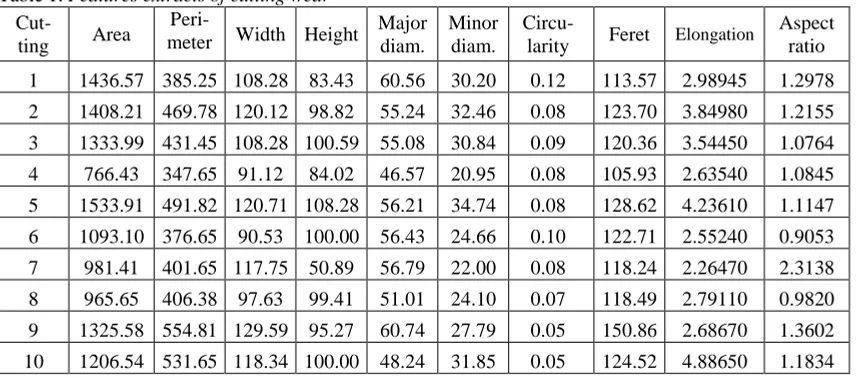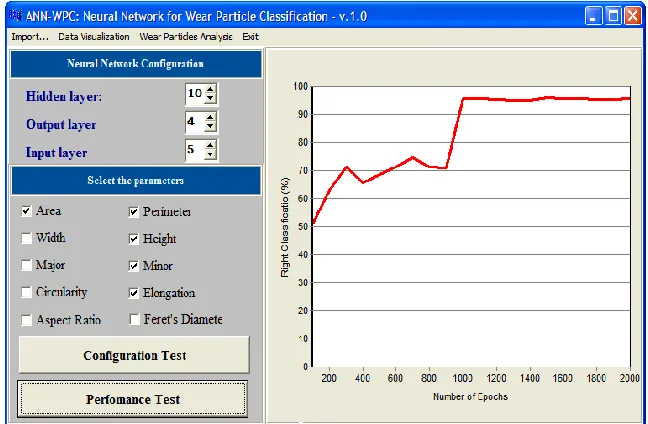Strojniški vestnik - Journal of Mechanical Engineering 56(2010)4, 277-281 Paper received: 23.02.2010
UDC 004.032.26 Paper accepted: 30.04.2010
*Corr. Author's Address: UNESP – São Paulo State University, Av. Dr. Ariberto Pereira da Cunha, 333, Zip
Code: 12516-410, Guaratinguetá, SP, Brazil, valdecidgoncalves@gmail.com 277
Wear Particle Classifier System Based on an Artificial Neural
Network
Valdeci Donizete Gonçalves1,* - Luis Fernando de Almeida2 - Mauro Hugo Mathias1 1 UNESP – São Paulo State University, Brazil
2 UNITAU – Taubaté University, Brazil
This paper describes a method to identify morphological attributes that classify wear particles in relation to the wear process from which they originate and permit the automatic identification without human expertise. The method is based on the use of Multi Layer Perceptron (MLP) for analysis of specific types of microscopic wear particles. The classification of the wear particles was performed according to their morphological attributes of size and aspect ratio, among others.
© 2010 Journal of Mechanical Engineering. All rights reserved.
Keywords: artificial neural network, wear particles analysis, expert system
0 INTRODUCTION
Wear particles, contained in lubricating oil, carry with them important information related to the condition of the corresponding machinery. Microscopic analysis of the wear particles in lubricating oil provides a powerful tool for predicting potential machine failure. The development of advanced systems for wear particle analysis is an essential tool for proactive maintenance in industrial plants.
This paper describes the use of a Multi Layer Perceptron (MLP) for analysis of the most common types of microscopic wear particles, i.e., Rubbing (R), Cutting (C), Severe Sliding (SS) and Fatigue (F). The MLP was trained and tested using a database, constructed with records related to the wear modes that are examined in this work. The wear particles classification was performed according to their morphological attributes of size and aspect ratio, among others. Oil monitoring, also known as wear particle analysis and physical analysis of lubricant properties, has been recognized as one of the most important approaches for condition monitoring and failure analysis [1].
Recent research efforts have been focused on the development of an automatic and efficient system to perform wear particle analysis, such as those using image processing, expert systems, knowledge-based systems and so on [2] and [3].
1 ARTIFICIAL NEURAL NETWORKS
Artificial Neural Networks (ANN) are known for their application in classification problems, including those related to the maintenance of machines [2] to [6]. They are composed of many simple elements, called neurons, operating in parallel and connected to each other by multipliers, called weights. Basically, an ANN is composed of the following:
Processing units or neurons (xi, hj, yk) receiving input from neighbours or external sources and using this to compute an output signal which is propagated to other neurons.
Weights determine the effect of one neuronal signal on another.
The activation function (f), an element that determines the level of neuron activation, is based on the effective input Σ.
There are many types of ANN, and Multilayer Perceptron (MLP) stands out as one of the most widely used. Fig. 1 illustrates a standard MLP with one hidden layer. The learning of a MLP is supervised; each input signal received from the environment is associated with a specific desired target pattern.
*Corr. Author's Address: UNESP - São Paulo State University, Av. Dr. Ariberto Pereira da Cunha, 333, Zip Code: 12516-410, Guaratinguetá, SP, Brazil, valdecidgoncalves@gmail.com 278
Fig. 1. Standard MLP with one hidden layer
Fig. 2. Classification system architecture
2 PROCEDURE FOR DEVELOPMENT
The learning and classification procedures are described in Fig. 2. At the initial phase, pictures of four kinds of known wear particles are introduced into a system to extract their features, and they are then saved into a database. Rubbing wear, severe sliding, cutting wear and fatigue were the types of wear particles used in this study. Ten individual features of each type of wear particle were analyzed to structure the database, which is used for MLP training and testing. After that, the MLP can be applied to classify unknown data from its features.
2.1 Features Extraction
The wear particle modelling proposed in this work is based on morphological attributes, which include area, perimeter, width, height, circularity, elongation, Feret diameter, major diameter, minor diameter and aspect ratio [11]. The process applied to identify the particle types consists of matching features extracted from a given input particle with those of the wear particle type models.
Strojniški vestnik - Journal of Mechanical Engineering 56(2010)4, 277-281
Wear Particle Classifier System Based On An Artificial Neural Network 279
system was developed using different stylized particles created from the set of wear mechanisms analyzed in this work.
Ten stylized particles of each kind of wear mechanism were prepared, forming a sample of forty binarized particles images related to the wear mechanisms under study. The Fig. 3 illustrates stylised particles type for cutting wear.
Table 1 shows the features of ten stylized particles, related to cutting wear mechanisms. Such features were obtained using ImageJ software [12].
The data obtained for all wear particles are used to feed the neural network system, which will process the data and classify the particles according to the kind of wear mechanism.
2.2 MLP Classifier
In this paper, a MLP with one hidden layer is used for particle classification. In order to define the appropriate net architecture, a set of tests with varying numbers of neurons in the hidden layer from 3 to 15 were carried out. The
database content was divided in two groups: training and test data. Both are represented by a
PxF matrix, where P represents the total number of training particles and F is the number of features used.
Due to the importance of input data pretreatment [8], both datasets have been normalized by using a simple linear scaling of the data, according to Eq. 1. The mini and maxi
variables represent the range of "i" normalized features, while dmin and dmax are the lower and
upper values for that feature, respectively.
) (
) (
) min (max min
min max
min , ,
d d
d d
ndij i i i ij
.
(1)In order to provide faster learning, weight initialization, developed by Nguyen and Widrow [9], was used. According to Fausett [7], this analysis is based on a hyperbolic tangent activation function, which is closely related to the bipolar sigmoid activation function described in Eq. 2.
f = -1 + 2/(1 + exp(-Σ)). (2)
Fig. 3. Stylised particles cutting wear
Table 1. Features extracts of cutting wear
Cut-ting Area
Peri-meter Width Height
Major diam.
Minor diam.
Circu-
larity Feret Elongation
Goncalves, V.D. - Almeida, L.F. - Mathias, M.H. 280
2.3 Neural Network for Wear Particle Classification
The first version of the program "Neural Network for Wear Particle Classification", Neural_WPC, was used to perform the tests. This program was created to analyze appropriated ANN configurations to classify wear particle mechanisms. This tool was divided into two modules, training network and particle classifier. The training network executes the MLP training and presents a graphic of the set rate of the trained ANN, and also allows the analyzing of a specific architecture related to the training time. The classification module allows for a classification of set particles according to wear modes trained into the ANN. Such resources are illustrated by Fig. 4.
3 TESTS AND RESULTS
The tests were carried out to determine the best set of features of the MLP to be used by the classifier. For this reason, all possible combinations between these features were considered. The MLP used has 5 neurons in the input layer, 10 in the hidden layer, and 4 in the
output layer. Table 2 shows the results of the best configuration.
From the best configuration, presented in Table 2, a test was conducted as a function of the performance, as measured by the number of epochs, i.e., learning time, varying from 100 to 2000. The final results are presented in Fig. 5, which shows the stability in training with 1000 epochs.
4 CONCLUSION
This article presents an important tool for the analysis of microscopic wear particles, found in the lubricating oil, by using Artificial Neural Networks. The results have demonstrated that the presented method, when executed through an ANN, may be successfully used for the characterization of wear particle profile attributes. However, it is also noted that the rate of accurate characterization can increase or decrease depending on the features chosen as inputs to the ANN. For the features used in these experiments, accurate classification was obtained at a maximum rate of 96%, with a standard deviation of 2%.
Fig. 4. ANN_WPC windows
Table 2. Best configuration for combinations between extracted features
Strojniški vestnik - Journal of Mechanical Engineering 56(2010)4, 277-281
Goncalves, V.D. - Almeida, L.F. - Mathias, M.H. 281
Fig. 5. Performance of the best configuration
Finally, the input data normalization and weight initialization used in this work allowed for a reasonable training time, about 1000 iterations. In future works, other analysis methods, like those for edge detail and texture and other wear particles types, will be analyzed.
5 REFERENCES
[1] Yan, X.P., Zhao, C.H., Lu, Z.Y., Zou, X.C., Xiao, H.L. (2005) A study of information technology used in oil monitoring, Tribology International, vol. 38, p. 879-886.
[2] Laghari, M.S., Memon, Q.A., Khuwaja, G.A. (2004) Knowledge based wear particle analysis. Transactions on Engineering, Computing and Technology, vol. 3, p. 112-116.
[3] Peng, Z. (2002) An integrated intelligence system for wear debris analysis, Wear, vol. 252, p. 730-743.
[4] Rafieea, J., Arvania, F., Harifib, A., Sadeghi, M.H. (2007) Intelligent condition monitoring of a gearbox using artificial neural network,
Mechanical Systems and Signal Processing
vol. 21, p. 1746-1754.
[5] Samanta, B., Al-Balushi, K.R. (2003) Artificial neural network based fault diagnostics of rolling element bearings using time-domain features, Mechanical Systems and Signal Processing, vol. 17, no. 2, p. 317-328.
[6] Laghari M.S. (2003) Recognition of texture types of wear particles, Neural Comput & Application, vol. 12, p. 18-25.
[7] Fausett L. (1993) Fundamentals of neural networks; architecture; algorithms and applications. Prentice Hall, Englewood Cliff. [8] Sola J., Sevilla J. (1997) Importance of input data normalization for the application of neural networks to complex industrial problems, Nuclear Science, IEEE Transactions, vol.44, p. 1464-1468.
[9] Nguyen D., Widrow B. (1990) Improving the Learning Speed of 2-Layer Neural Networks by Choosing Initial Values of the Adaptive Weights, Proceedings of the International Joint Conference on Neural Networks, San Diego, USA, , vol. 3, p. 21-26.
[10] Gonçalves, V.D., Mathias M.H. (2007) A Mechatronic System Applied to wear Particle Analysis, Slovenian Society for Tribology, ECOTRIB, Slovenia, vol. 2, p. 1065-1072.
[11] Xu, K., Luxmoore, A.R., Jones, L.M., Deravi, F. (1998) Integration of neural networks and expert systems for microscopic wear particle analysis, Knowledge-Based Systems vol. 11, p. 213-227.



